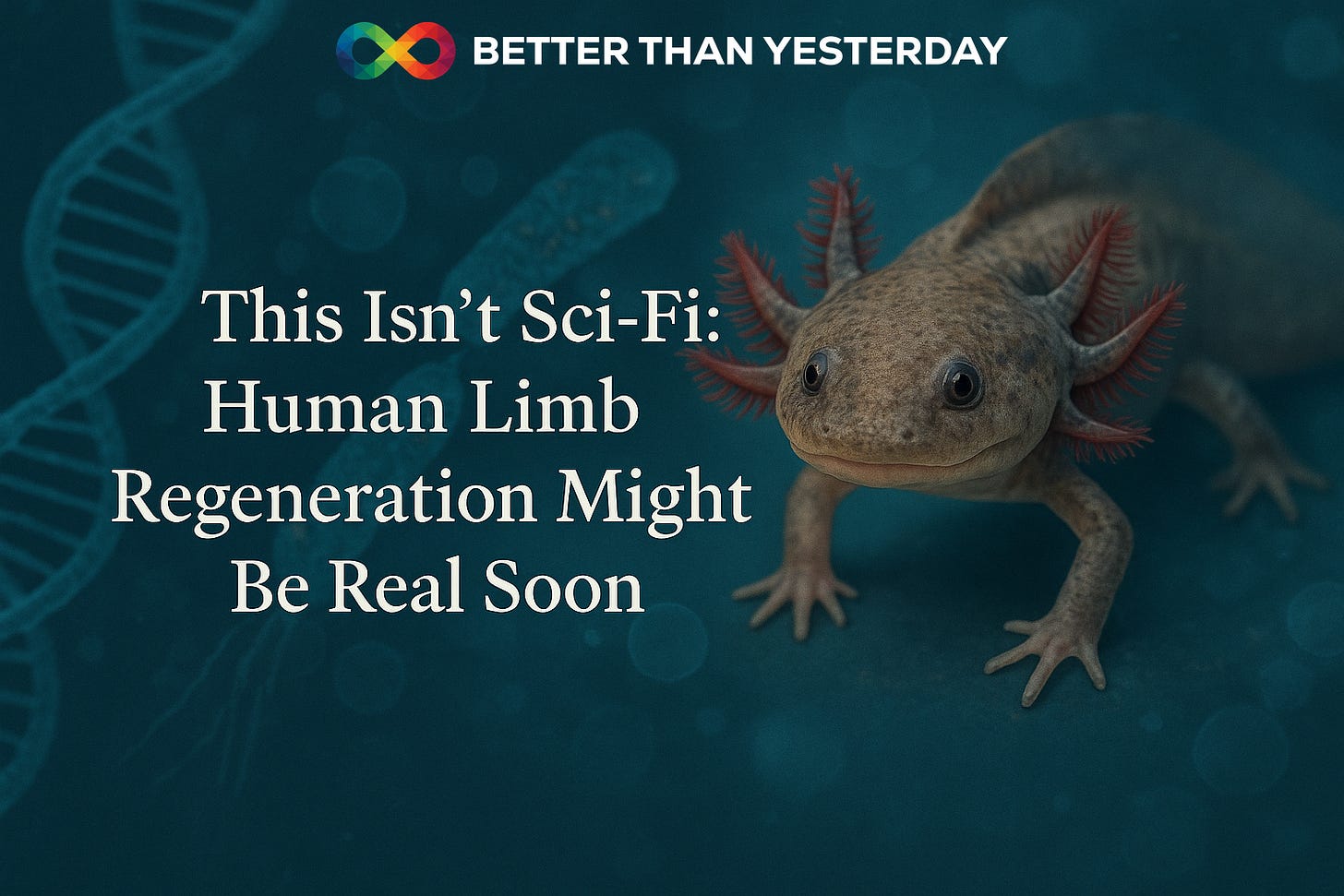Human Limb Regrowth Might Be Closer Than We Think
Two new studies on salamanders and axolotls reveal the same regeneration blueprint may be hiding in human DNA

A few years ago, this would’ve sounded like science fiction: regrowing a human limb.
But today, scientists are getting closer, by learning from creatures that already do it perfectly.
Two major studies just revealed how salamanders and axolotls rebuild entire limbs, and the shocking part?
Humans share the same genes. We’ve just never activated them.
🦎 Study #1: Salamanders and the “Where-Am-I?” Code
Published in Nature (June 2025), researchers studied how salamanders rebuild limbs with pixel-level accuracy.
Not just a finger or a stump, a complete, functioning arm.
They discovered a gene feedback loop: Hand2 + Shh.
It acts like GPS for your cells. It tells them:
“You’re the elbow. Build an elbow.”
“You’re the wrist. Build a hand.”
This is called positional memory, and here’s the wild part:
🧬 Humans still carry this gene circuit. We just stop using it after birth.
Think of it like software running in the background, locked, but not deleted.
🧪 Study #2: Axolotls and the Chemical Shortcut
Meanwhile, over at Northeastern University, researchers led by James Monaghan figured out how to trick limb cells into regenerating more than they should.
Normally, when an axolotl loses a hand, it regrows a hand.
But when scientists blocked an enzyme called CYP26B1, something strange happened:
The axolotl grew an entire extra arm.
How? That enzyme normally breaks down retinoic acid, a molecule that helps cells identify their position on the limb.
Block it → retinoic acid floods the tissue → cells get confused → they think they’re near the shoulder → full arm grows back.
They also discovered the key gene behind it: Shox
(short stature homeobox).
It's the master builder for arm bones, and yes, humans have it too.
🧬 So… Can Humans Actually Regrow Limbs?
Not yet. But we’re closer than anyone expected.
Here’s what these studies confirm:
✅ Humans have the same core genes for regeneration
✅ Our bodies simply default to scarring, not rebuilding
✅ With the right signal, those pathways could be reactivated
No gene editing. No sci-fi tech.
Just unlocking what’s already inside us.
“The dream is to go from scar tissue to blastema,” says Monaghan.
That’s the name for the stem-cell soup that regrows entire body parts.
🔬 Why This Matters for Biohackers
From a regenerative medicine and biohacking standpoint, this changes everything.
If researchers can induce positional memory + blastema formation, it opens doors to:
🦾 Limb and nerve regeneration
🫀 Organ repair and scar reversal
🧠 Brain and spinal healing after trauma
The focus now shifts from gene editing to reactivating dormant instructions.
That’s a much safer, more accessible path.
This also means future regenerative therapies might use:
CYP26B1 inhibitors (like talarozole)
Localized retinoic acid delivery
CRISPR to guide positional info, not rewrite whole genomes
📚 Sources
🧠 TL;DR
Salamanders use a GPS-like gene loop to regrow limbs
Axolotls can be chemically tricked into building more than needed
Humans share these genes—but don’t activate them after injury
These studies offer a roadmap for full-body regeneration—without editing DNA
🌿 My Thought
This isn’t about superpowers.
It’s about remembering what biology forgot.
The same way we learned how to extend lifespan through fasting, NAD boosters, or circadian syncing, regeneration might be the next leap.
And the biggest biohack of the next decade… could be waking up ancient instructions already written into us.


